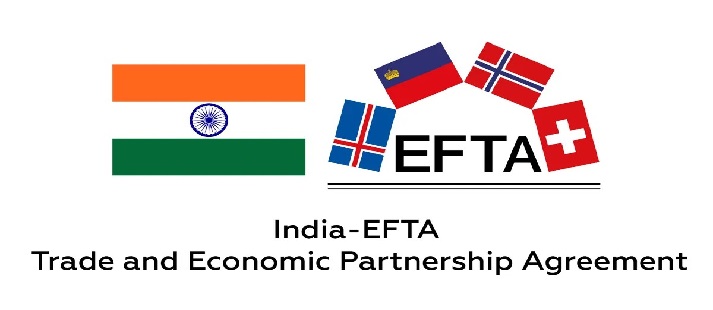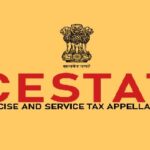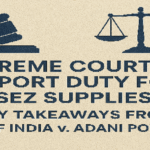Introduction
On 1 October 2025, India’s Trade and Economic Partnership Agreement (TEPA) with the European Free Trade Association (EFTA) comes into force. The EFTA states comprise Switzerland, Norway, Iceland, and Liechtenstein. After nearly 16 years of negotiations, this marks India’s first trade agreement with a European bloc. The pact includes, for the first time in an Indian trade agreement, a binding investment and job creation commitment: USD 100 billion in investment and 1 million direct jobs in India over 15 years.

Below is a professional-legal overview of the agreement’s key features, the customs / trade facilitation implications, and the existing or newly issued notifications by Indian customs.
Key Features of TEPA (India-EFTA)
- Tariff liberalisation / elimination
- The agreement schedules the elimination or reduction of customs duties on goods originating in each Party according to detailed tariff commitments in Annexes 2.C / 2.D / 2.E / 2.F.
- India has opened 82.7% tariff 82.7% of its tariff lines which covers 95.3% of EFTA exports.
- However, gold remains largely outside concession: over 80% of EFTA’s exports to India are in the form of gold/channels connected to bullion markets; India retains its duty regime on gold.
- The EFTA side similarly commits elimination of 92.2 % of tariff lines comprising of 99.6 % of India’s export value to EFTA at 0% Customs Duty.
2. Rules of Origin & Proofs of Origin
- To benefit from preferential tariffs, a good must satisfy the origin criteria as set out in Annex 2.A (and its appendices).
- Proofs of origin may be via (i) a certificate of origin issued by official authority, or (ii) a self-declaration origin if the exporter is approved, conforming to Appendix 2.A.3 or 2.A.4 (movement certificate EUR.1) rules.
- The exporter and importer must maintain records and allow verification by customs of either Party. Verification procedures can include on-site inspections, audit of records, and requests for origin evidence.
- The importer must request preferential tariff treatment at the time of import, submitting proof of origin.
3. Other disciplines
- The agreement addresses trade remedies (anti-dumping, countervailing, safeguards) and incorporates relevant WTO rules.
- It covers trade in services, investment promotion and protection, intellectual property, government procurement, competition policy, sustainable development, dispute settlement, and institutional provisions.
- A unique feature: the EFTA side has committed to invest USD 100 billion in India over 15 years, and India has committed to creating 1 million direct jobs
4. Entry into Force & Ratification
- The agreement was signed on 10 March 2024.
- It enters into force on 1 October 2025.
- Now that the agreement is operational, its provisions (especially on tariffs and customs) become legally binding on both sides
Customs Notifications in India Relating to TEPA / EFTA
To operationalise the tariff concessions promised under TEPA, the Central Board of Indirect Taxes and Customs (CBIC) has issued a set of notifications dated 30 September 2025. These give legal effect to the first tranche of tariff concessions under the India-EFTA TEPA.
The relevant notifications are:
- Notification No. 41/2025-Customs (30-09-2025)
Seeks to give effect to the first tranche of tariff concessions under India-EFTA (Switzerland). - Notification No. 42/2025-Customs (30-09-2025)
Seeks to give effect to the first tranche of tariff concessions under India-EFTA (Norway). - Notification No. 43/2025-Customs (30-09-2025)
Seeks to give effect to the first tranche of tariff concessions under India-EFTA (Norway).
These notifications amend the Customs Tariff Act, 1975 schedules to reflect preferential duty rates agreed in TEPA. They provide the legal basis for importers in India to claim reduced or zero duty on eligible goods originating in the EFTA countries, subject to compliance with the Rules of Origin and proof of origin requirements laid down in Annex 2.A of the Agreement
Major Beneficiary Sectors
1. Pharmaceuticals & Medical Devices
- Switzerland and Norway are hubs for advanced pharma and life sciences. Indian pharma exports (generics, APIs, formulations) gain easier entry through tariff elimination and harmonised standards.
- Medical device exports (diagnostic equipment, consumables) also benefit from reduced tariffs
2. Textiles & Apparel
• EFTA has strong demand for Indian apparel, home furnishings and technical textiles. Lower tariffs will improve India’s competitiveness against Asian rivals in these high-value markets
3. Gems & Jewellery (other than gold imports)
• Export of cut and polished diamonds, precious stones, and jewellery will see lower tariffs, strengthening India’s role as a global jewellery hub.
4. Engineering Goods & Machinery
• Indian exports of automotive components, light engineering products, pumps, valves, tools, and electrical machinery stand to benefit from duty elimination on industrial products.
5. Chemicals & Petrochemicals
• Organic chemicals, specialty chemicals, and intermediates will face lower tariff barriers in EFTA states, giving Indian chemical exporters access to niche industrial markets.
6. IT Services & Professional Services
• Beyond goods, TEPA provides improved market access in services. Indian IT, consulting, accounting, and legal services firms will benefit from commitments on recognition, mobility, and cross-border supply
7. Processed Food & Beverages (Selective)
• Certain processed agri products like spices, ready-to-eat foods, and select marine products receive improved tariff access. Sensitive items like dairy and cereals remain protected.
Implications & Practical Advice for Traders, Customs Practitioners, Importers / Exporters
- Traders should verify whether their products qualify as originating goods under TEPA before claiming preferential treatment, and maintain the required documentation (e.g. supplier declarations, origin proofs) for at least five years (or longer as per domestic law).
- At import clearance, the importer must claim the preferential tariff and submit proof of origin when required. If not submitted, they may request preferential treatment afterwards (if permitted under domestic rules).
- Customs authorities may verify origin claims, hence importers/exporters must cooperate and provide records, and may face denials or recovery of duties if obligations are not met.
- For any goods whose preferential treatment is contested, the importer should expect a written determination with reasons.
- Some tariff lines may still retain transitional or gradual phase-outs, or special conditions (especially in sensitive sectors). Businesses should closely refer to the TEPA tariff schedules.
Conclusion
The India-EFTA TEPA creates an unprecedented legal and economic framework for India’s trade with Europe. With the customs notifications now in place, preferential market access is legally available. Businesses should act quickly to align supply chains, ensure compliance with origin requirements, and capture the benefits of reduced tariff barriers in EFTA markets.





